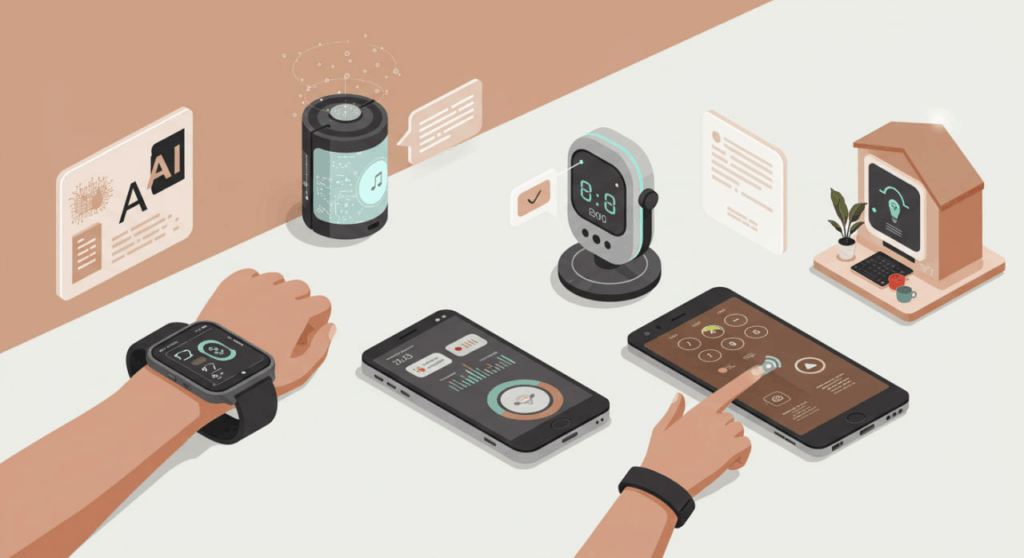Artificial Intelligence (AI) is no longer confined to research labs or sci-fi movies; it’s weaving its way into the fabric of our daily lives, transforming the gadgets we use into smarter, more intuitive companions. From smartphones that anticipate our needs to home appliances that learn our habits, AI is reshaping how we interact with technology. This article explores the exciting advancements in AI integration within everyday gadgets, delving into current innovations, future possibilities, and the impact on user experience. Whether you’re a tech enthusiast or simply curious about what’s next, join us as we uncover how AI is set to redefine the devices we rely on every day.
Why AI in Gadgets Matters
The integration of AI into everyday gadgets isn’t just about flashy features; it’s about creating seamless, personalized experiences that make life easier. AI enables devices to process vast amounts of data, learn from user behavior, and adapt in real-time. Imagine a smartwatch that not only tracks your heart rate but also predicts potential health issues based on subtle patterns or a refrigerator that suggests recipes based on its inventory. These advancements are driven by machine learning algorithms, natural language processing, and computer vision, which allow gadgets to understand context, make decisions, and even communicate with us in human-like ways. As AI continues to evolve, its presence in gadgets is becoming a game-changer, enhancing convenience, efficiency, and connectivity in our daily routines.
Current AI-Powered Gadgets We Love
AI is already making waves in the gadgets we use today, turning ordinary devices into intelligent assistants. Smartphones, for instance, leverage AI for features like voice assistants (think Siri or Google Assistant), which understand and respond to natural language queries with increasing accuracy. Cameras in these devices use AI to optimize photo quality, automatically adjusting settings for lighting and focus to deliver professional-grade shots. Smart home devices like the Amazon Echo or Google Nest Hub take it a step further, using AI to control lighting, thermostats, and even security systems with simple voice commands. Wearables, such as the Apple Watch or Fitbit, employ AI to analyze health metrics, offering insights into sleep patterns, exercise routines, and stress levels. These examples showcase how AI is already enhancing functionality, but they’re just the tip of the iceberg.
AI in Smartphones: Beyond Voice Assistants
Smartphones are at the forefront of AI integration, serving as the hub for many of our daily tasks. Beyond voice assistants, AI powers features like predictive text, which learns your typing habits to suggest words or phrases, and facial recognition for secure unlocking. Companies like Apple and Google are embedding AI chips, such as the A17 Bionic or Tensor G4, to process tasks on-device, ensuring faster performance and better privacy. AI-driven photography is another standout, with algorithms that enhance low-light shots, recognize scenes, and even edit videos in real-time. In the future, we can expect smartphones to become even more proactive—perhaps suggesting apps based on your schedule or automatically organizing your emails based on priority. The possibilities are endless, and the focus is on making these devices feel like true extensions of ourselves.
Smart Homes: AI as the Ultimate Housekeeper
The smart home ecosystem is where AI truly shines, turning houses into responsive environments. Devices like smart thermostats (e.g., Nest Learning Thermostat) use AI to learn your temperature preferences and optimize energy usage, saving you money while keeping you comfortable. AI-powered security cameras, like those from Ring or Arlo, can distinguish between a delivery person and a potential intruder, sending tailored alerts to your phone. Even kitchen appliances are getting smarter—Samsung’s Family Hub refrigerator uses AI to track food inventory, suggest recipes, and even display grocery lists on its touchscreen. As AI advances, we’ll see smarter integration across devices, creating homes that anticipate our needs, from adjusting lighting for movie nights to preheating ovens when you’re on your way home.

The Future: What’s Next for AI in Gadgets?
Looking ahead, the future of AI in everyday gadgets is both thrilling and transformative. One major trend is the rise of edge AI, where processing happens directly on the device rather than in the cloud. This not only speeds up performance but also enhances privacy by keeping data local. Imagine a smart speaker that processes your voice commands without an internet connection or a wearable that analyzes your health data in real-time without uploading it to a server. Another exciting development is the integration of generative AI, which could enable gadgets to create content—like personalized workout plans or custom music playlists—based on your preferences. Additionally, AI is poised to make gadgets more sustainable, optimizing energy consumption in devices like air conditioners or electric vehicles to reduce environmental impact.
AI in Wearables: Your Personal Health Coach
Wearable technology is set to become even more integral to our lives, with AI driving unprecedented personalization. Future smartwatches and fitness trackers could go beyond monitoring to predicting health risks, such as detecting early signs of conditions like diabetes or heart disease through advanced data analysis. AI could also enable real-time coaching, offering tailored advice during workouts or suggesting mindfulness exercises when stress levels spike. Companies like Fitbit and Oura are already experimenting with AI-driven sleep analysis, but the next generation of wearables might integrate with medical systems, sharing insights with healthcare providers to offer proactive care. This shift could turn wearables into indispensable tools for preventive health, empowering users to take charge of their well-being.
Autonomous Gadgets: The Rise of Self-Sufficiency
Another frontier is the development of autonomous gadgets powered by AI. Think of robotic vacuum cleaners like the iRobot Roomba, which already use AI to map your home and avoid obstacles. In the future, we could see fully autonomous lawnmowers, kitchen assistants, or even drones that handle tasks like package delivery or home surveillance. These devices will rely on advanced AI to navigate complex environments, make decisions, and learn from their surroundings. For example, a future Roomba might not only clean your floors but also detect spills, adjust its cleaning intensity, and coordinate with other smart home devices to ensure a spotless home. This level of autonomy will redefine convenience, freeing up time for more meaningful activities.
Challenges and Considerations
While the future of AI in gadgets is bright, it’s not without challenges. Privacy remains a top concern, as AI-powered devices collect vast amounts of personal data. Manufacturers must prioritize robust encryption and transparent data policies to build user trust. Another issue is accessibility—AI gadgets can be expensive, potentially creating a divide between those who can afford them and those who can’t. Additionally, the rapid pace of AI development raises questions about e-waste, as older devices may become obsolete faster. Addressing these challenges will be crucial to ensuring that AI’s benefits are equitable and sustainable, allowing everyone to enjoy the perks of smarter gadgets without compromising privacy or the environment.
How AI Enhances User Experience
At its core, AI in gadgets is about creating a frictionless user experience. By learning from our habits, AI makes devices more intuitive, reducing the need for manual input. For instance, a smart TV might recommend shows based on your viewing history, while a car’s AI system could adjust seat settings and climate control based on your preferences. This personalization creates a sense of connection with our devices, making them feel less like tools and more like partners. Moreover, AI’s ability to automate repetitive tasks—like scheduling reminders or managing smart home devices—frees up mental space, allowing us to focus on what matters most. As AI continues to evolve, the user experience will only become more seamless, intuitive, and delightful.
The Role of Interconnectivity
One of the most exciting aspects of AI in gadgets is its ability to foster interconnectivity. Smart ecosystems, like Apple’s HomeKit or Google’s Home, allow devices to communicate with each other, creating a cohesive experience. For example, your smartwatch could detect that you’re waking up and signal your coffee maker to start brewing. In the future, AI could take this a step further, enabling cross-device collaboration that anticipates complex needs. Imagine a scenario where your car’s AI syncs with your calendar, adjusts your commute route based on traffic, and notifies your smart home to warm up the house before you arrive. This level of integration will make our gadgets work together as a unified system, amplifying their usefulness and convenience.
FAQs
How is AI currently used in everyday gadgets?
AI is embedded in many gadgets we use daily, such as smartphones, smart speakers, and wearables. It powers features like voice assistants, facial recognition, photo enhancement, and health tracking. For example, smartphones use AI to optimize battery life, while smart thermostats learn your preferences to save energy.
What are the benefits of AI in gadgets?
AI enhances gadgets by making them more intuitive, personalized, and efficient. It automates tasks, improves user experience through predictive features, and enables devices to learn from user behavior. This leads to greater convenience, energy savings, and even improved health monitoring.
Are there privacy concerns with AI-powered gadgets?
Yes, privacy is a significant concern, as AI gadgets often collect personal data to function effectively. To address this, manufacturers are implementing on-device processing (edge AI) and stronger encryption. Users should review data policies and choose devices from reputable brands to ensure privacy.
What’s the future of AI in wearable technology?
The future of AI in wearables includes advanced health monitoring, such as predicting medical conditions, offering real-time coaching, and integrating with healthcare systems. Wearables may also become more personalized, tailoring recommendations for fitness, sleep, and stress management based on individual data.
How will AI make gadgets more sustainable?
AI can optimize energy usage in devices like smart thermostats, air conditioners, and electric vehicles, reducing environmental impact. Additionally, AI could improve recycling processes for gadgets and extend device lifespans by predicting maintenance needs, contributing to a more sustainable tech ecosystem.



